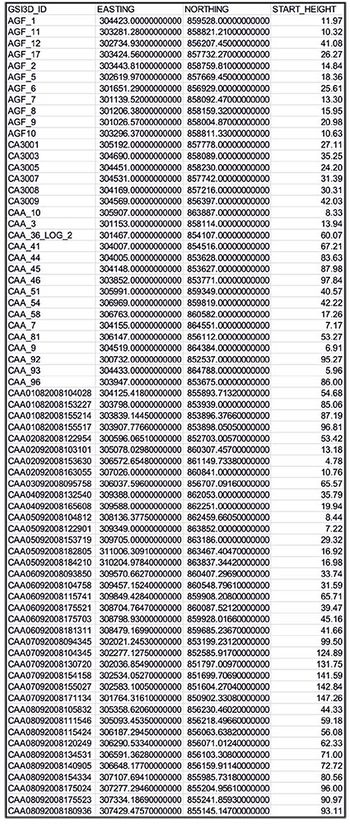OR/14/057 Model datasets
| Arkley, S L B, Finlayson, A G, and Callaghan, E A. 2014. Model metadata report for the Forres GSI3D superficial deposits model. British Geological Survey Internal Report, OR/14/057. |
The data used to develop the Forres model is described below. Some general caveats regarding BGS datasets and interpretations are:
- Geological observations and interpretations are made according to the prevailing understanding of the subject at the time. The quality of such observations and interpretations may be affected by the availability of new data, by subsequent advances in knowledge, improved methods of interpretation, improved databases and modelling software, and better access to sampling locations.
- Raw data may have been transcribed from analogue to digital format, or may have been acquired by means of automated measuring techniques. Although such processes are subjected to quality control to ensure reliability where possible, some raw data may have been processed without human intervention and may in consequence contain undetected errors.
Raw data
Raw data used to develop the Forres model include the digital terrain model, borehole data, digital geological map shapefiles, and records of exposures and trial pits. The file locations of the data used are given in Appendix 1.
The DTM used for the Forres model is the NEXTMap® Digital Elevation Model (exported from the BGS data portal). Originally the DTM was imported at 10 m resolution from the data portal but problems were incurred possibly due to the file size being too large. The resolution was decreased to 25 m and the area of the DTM extended beyond the model area in each direction but was later clipped in GSI3D before computing volumes.
The Rock Head Elevation Model (RHEM) grid was also imported from the data portal and similar issues to the DTM occurred. Again the resolution was decreased to 25 m.
Data (boreholes)
Borehole data were entered into the BGS corporate database, BGS Borehole Geology according to the project GVS. The borehole information was extracted via the Data Portal (10/07/2009) for the model area using interpreter ‘ECAL’ and in total there were 392 boreholes and trial pits. Boreholes were generally hung according to the DTM used, however where the DTM was affected by artefacts, e.g. trees, the boreholes were aligned with the contour values.

Data (field information/points)
Field data points providing information on the deposits and their thickness were compiled into Excel tables and converted into ‘.bid’ and ‘.blg’ files for use in the modelling. Two different sources of field data were used:
- information from old geological fieldslips and maps (Table 2) and,
- map face notes and field observations from the recent field survey compiled from SIGMA mapping projects (Table 3).


Data (geological)
Superficial, artificial and landform polygons were provided by the field geologists who had undertaken mapping in this area between 2008 and 2011. These files were provided as 3D shapefiles for use in GSI3D by CartoGIS. To convert a 2D-shapefile to a 3D-shapefile, software from the web was used and was imported into an Arc GIS project, converted and resaved.
Data (rasters and shapefiles)
Topographic maps at 1:10 000, 1:25 000 and 1:50 000 scales were extracted for the project area. 3D contours for the area are available as a shapefile but had to be converted into 2D using ARC, the same process for converting the geological linework.
Additional data
Five cross sections from MacDonald et al. (2007)[1], constructed to assess lithological variation within part of the study region, were examined prior to modelling (an example section is provided in Figure 3). Four of these sections were imported as jpeg images into the modelling project to help guide cross-section construction.
Faults within the cross-sections have been interpreted from the district geologist’s field observations and knowledge.
